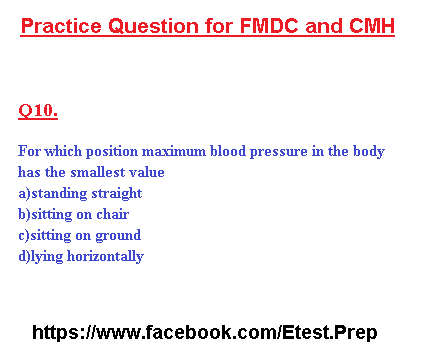Delta is the answer
While lying horizontally, the body is in relaxed state the arteries are not dilated, furthermore the heart don't have to pump blood against gravity.
Over the train is correct answer.
‘A fast moving train’ these are the key words of this question.
As train is moving fast pressure around it will be low than the outer space, this will cause a pressure gradient. As everything moves from high pressure to low pressure so the man standing near the fast moving train will be drawn towards the train.
The correct answer is 4:9, since the radii are in the ratio of 2:3 and their mass must be unequal if density is constant, the terminal velocity is given by
vt = (2gr2 ρ)/9η
From above formula it is clear that terminal velocity is directly proportional to the square of radius.
But in book there is one more equation in which terminal velocity is inversely proportional to the radius.
vt = mg/6πηr
The first equation will be used when density is constant and mass is a variable quantity and second equation is used when mass is constant like in the example of paratroopers where r becomes larger but mass don’t remains the same.
The rotational K.E. is given by
(K.E)rotational = 1/2 Iω2
For hoop I = mr2
So
(K.E)rotational = 1/2 mv2
Which is equal to translational kinetic energy?
The answer is Benzene, which is non-polar. The other three compounds are miscible in water but benzene in water is an example practically immiscible liquids.
An acid weaker than carboxylic acid.
Just recall this trend written in the topic of phenols
Acidic strength :
Carboxylic acids > phenols > water > alcohols
And also remember that inorganic acids like HCl are always stronger than organic ones.
Delta is answer
Divinyl acetylene is the answer. The formula is given in the preparation of Neoprene in Alkyne section just name it according to IUPAC nomenclature.
Addition of HX to unsymmertical alkenes is governed by Markonikov's rule which is a two step mechanism.












this is most wonderful site, helpful for entry test nice and easy tips are present, i am really impressed god bless u alot!
ReplyDeleteThank you :)
ReplyDeleteExcellent post, thanks for sharing the informative blog, it's create an interest of reading blog to learn new updates.
ReplyDeleteregards
Sofa Cleaning services in Islamabad